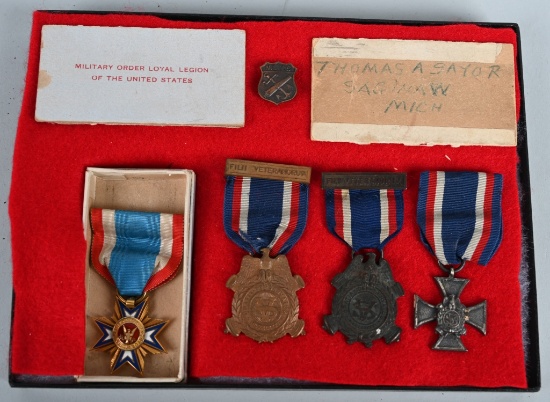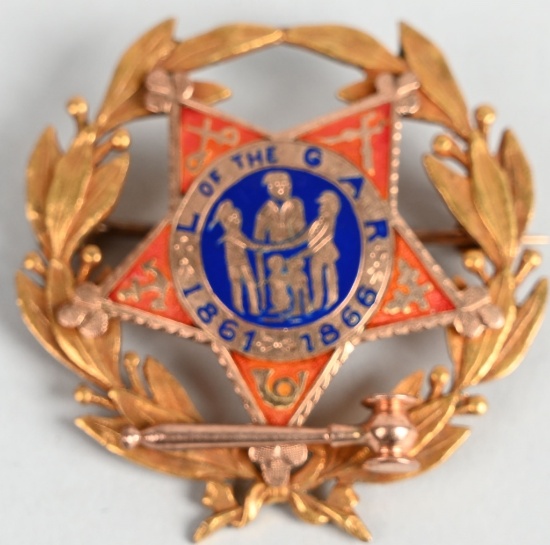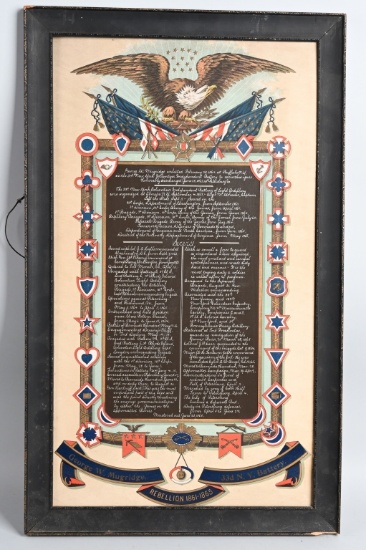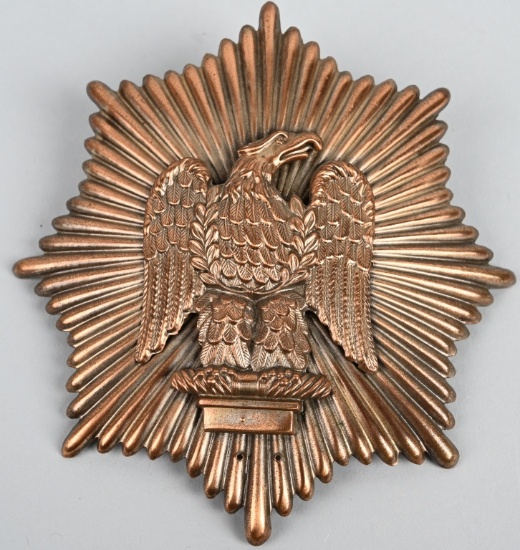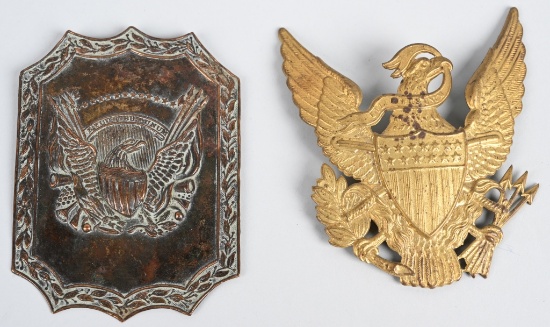
JUNE MILITARY EXTRAVAGANZA

JUNE MILITARY EXTRAVAGANZA
See Special Terms for additional fees
Cash Payment Discount: 3%
Description
PROUDLY PRESENTS:
JUNE MILITARY EXTRAVAGANZA
850 Plus Lots Of Military Items From 18th Century To Modern
Civil War and Indian Wars: Swords, Images, Gettysburg Carved Cane with Corps Badges, Indian Wars Frock Coat and More!!
WWII Nazi German: Uniforms, Adolf Hitler Silverware, Photos, Medals, Helmets, Knives, Daggers, Swords, Nazi Flags and Much More!!
WWII: U.S. Patriotic Posters, Soldier Grouping, Uniforms, Bayonets, Accoutrements, Medals, Japanese Flags, Uniforms, Helmets, Swords, Photos, Flags and Much More!!
POLICE DEPARTMENT: Huge collection of Police and Detective Badges, Photos, Hand Cuffs, 1865 and 1878 New York City Police Registers and Much More!!
SATURDAY June 20th, 2020
10:00 AM
"FULL CATALOG & LIVE BIDDING AVAILABLE THRU"
WWW.MILESTONEAUCTIONS.COM LIVEAUCTIONEERS, INVALUABLE, & PROXIBID
PHONE BIDS & ABSENTEE BIDS Call 440-527-8060
MILESTONE AUCTIONS GALLERY
"NEW... Show more Show Less
Cash Payment Discount: 3%
Participation Requirements: Valid Credit Card required for bidding approval
Payment Options: Visa, MasterCard, Discover, American Express, Check, Money Order, and Wire Transfer
Visa MasterCard Discover American Express
Payment Instructions: SALES TAX All buyers will pay applicable state sales tax. Sales Tax will be charged unless the item is being shipped out of state or the buyer provides a current state exemption form. PAYMENT All merchandise must be paid in full within ten (10) days of the date of the sale. Purchases totaling $20,000 or more must be paid within three (3) days of the date of the sale. Call 440-527-8060 to pay your invoice by phone or mail payment to: 38198 Willoughby Parkway, Willoughby Ohio, 44094. Absentee bids placed through www.milestoneauctions.com and Proxibid.com will be auto charged to the credit card entered 48 hours after the end of the sale. If you wish to pay by another method please contact us within 48 hours after the sale. We accept Visa, MasterCard, Discover, personal checks/ certified checks, wire transfer, money orders, and cash. CREDIT CARD - For first time buyers and credit card charges greater than $2,500.00 buyers must complete the bottom portion of the invoice and must specifically sign the acknowledgement of our terms of sale before we will accept payment via credit card. We do offer the convenience of paying automatically by credit card. If you wish have your card automatically charged for all purchases please complete our Authorization for Automatic Credit Card Use. We have this form available upon request. Split payments are subject to a 23% buyers premium if a credit card is used as any form of total payment. CHECK - There will be a $30.00 service charge for returned checks. Make checks payable to: Milestone Auctions LLC. Milestone Auctions reserves the right to hold items paid for by personal or company check until said check clears (14 days). Milestone Auctions has the right to hold all checks over $2,000.00. Customers who have an established successful buying history with Milestone Auctions may be exempt from this. In the few situations where a successful bidder does not remit payment when due, Milestone Auctions will proceed with the legal steps necessary to protect its interests and will block the bidder from future auction participation.
Currency Type: USD
Shipping Instructions: Please see our terms and conditions.
Preview Date & Times: Items are available for preview 7 days prior to the sale by appointment. Auction day preview is June 20th at 8AM.
Checkout Date & Times: Please contact the auction company for checkout dates & times.
Location: 38198, Willoughby Hills, OH 44094
Driving Directions:

By clicking "Confirm Buy" you are agreeing to the terms of the sale. Instant Purchase items may have additional fees such as an Internet Premium, Sales Tax, Shipping or other fees not included in the Instant Purchase price. Please see Auction Information for full details.
Payment Type:
KINGS GUARD 2ND REGIMENT NAPOLEON TROOP DISCHARGE
Lot # 1 (Sale Order: 1 of 931)
CIVIL WAR UNIT HISTORY OF FULLER'S OHIO BRIGADE OV
Lot # 2 (Sale Order: 2 of 931)
CIVIL WAR VETERAN MOLLUS MEDAL GROUPING W BOX NUMD
Lot # 2a (Sale Order: 3 of 931)
CIVIL WAR OHIO COMMISSION 1st LT. 62ND OVI FRAMED
Lot # 3 (Sale Order: 4 of 931)
CIVIL WAR GAR BADGE 132ND PA. INFANTRY BADGE
Lot # 4 (Sale Order: 5 of 931)
LADIES OF THE GAR GOLD PRESIDENTS BADGE CIVIL WAR
Lot # 4a (Sale Order: 6 of 931)
1826 OHIO MILITIA COMMISSION TO AID DE CAMP
Lot # 5 (Sale Order: 7 of 931)
CIVIL WAR GETTYSBURG CARVED CANE W/ CORPS BADGES
Lot # 6 (Sale Order: 8 of 931)
CIVIL WAR CDV OF KNOCKED OUT CONFEDERATE GUN
Lot # 7 (Sale Order: 9 of 931)
CIVIL WAR NON REGULATION OFFICER SWORD CLAUBERG
Lot # 8 (Sale Order: 10 of 931)
CIVIL WAR 123RD OHIO IDENTIFIED DOUMENT GROUPING
Lot # 9 (Sale Order: 11 of 931)
CIVIL WAR CAVALRY M1851 NCO SWORD BELT SHOULDER SP
Lot # 10 (Sale Order: 12 of 931)
CIVIL WAR ROSE AMBROTYPE OF FEDERAL SOLDIER w KEPI
Lot # 11 (Sale Order: 13 of 931)
INDIAN WARS DOUBLE BREASTED FROCK COAT NEW YORK
Lot # 12 (Sale Order: 14 of 931)
DOUBLE ARMED CIVIL WAR TINTYPE CASED RIFLE PISTOL
Lot # 13 (Sale Order: 15 of 931)
IMPERIAL GERMAN NOTGELD CURRENCY 320 COUNT LOT
Lot # 14 (Sale Order: 16 of 931)
IMPERIAL GERMAN NOTGELD CURRENCY 331 COUNT LOT
Lot # 15 (Sale Order: 17 of 931)
IMPERIAL GERMAN NOTGELD CURRENCY 530 COUNT LOT
Lot # 16 (Sale Order: 18 of 931)
IMPERIAL GERMAN NOTGELD CURRENCY 331 COUNT LOT
Lot # 17 (Sale Order: 19 of 931)
WW1 CHIEF OF CHAPLAINS SELF PORTRAIT JULIAN YATES
Lot # 18 (Sale Order: 20 of 931)
CIVIL WAR CDV LOT OF GENERAL BANNING 195TH OVI
Lot # 19 (Sale Order: 21 of 931)
CIVIL WAR DOUBLE ARMED AMBROTYPE IMAGE CASED
Lot # 20 (Sale Order: 22 of 931)
CIVIL WAR ESCUTCHEON 33RD NEW YORK BATTERY
Lot # 20a (Sale Order: 23 of 931)
RARE 1833 US DRAGOON SHAKO HELMET FRONT PLATE
Lot # 20b (Sale Order: 24 of 931)
EARLY US ARMY SHAKO HELMET PLATE LOT OF 2
Lot # 20c (Sale Order: 25 of 931)
| Bid Range | Increment |
| $0.00 - $299.99 | $10.00 |
| $300.00 - $999.99 | $25.00 |
| $1,000.00 - $1,999.99 | $50.00 |
| $2,000.00 - $4,999.99 | $100.00 |
| $5,000.00 - $9,999.99 | $250.00 |
| $10,000.00 - $24,999.99 | $500.00 |
| $25,000.00 - $49,999.99 | $1,000.00 |
| $50,000.00 - $99,999.99 | $2,500.00 |
| $100,000.00+ | $5,000.00 |

 x Cancel
x Cancel

